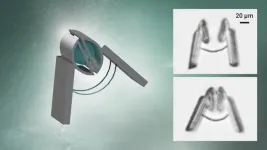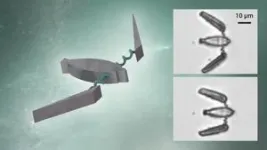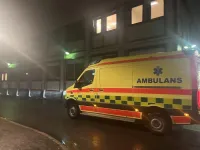(Press-News.org) These “picosprings” have remarkably large and tuneable compliancy and can be controlled remotely through magnetic fields (even deep within the human body) allowing articulated motion in microrobots as well as micromanipulations well beyond the state of the art.
Moreover, the extension of the picosprings can also be used visually to measure forces, for example propulsion or grasping forces, in interaction with other objects like cells. For example, these picosprings have been used to measure the locomotive propulsion force of sperm cells. The publication showcases these capabilities by demonstrating several microbots (including a micropenguin) containing picosprings at multiple locations that can do these tasks at cellular scales: propel themselves, grasp and release cells and measure the minute forces needed to do this safely. Figures 1 and 2 show two of these novel spring-loaded structures – a microgripper and a micropenguin extracted from the publication [https://doi.org/10.1038/s41565-023-01567-0].
Dr. Haifeng Yu, first author of the study and group leader at the Chinese Academy of Sciences in Shenzhen (China), says: “Programmable elasticity at the micrometer scale offers a feasible strategy for producing 3D devices and finely structured ‘micro-surgeons’ capable of performing complex medical tasks”.
Dr. Mariana Medina-Sanchez, group leader at the Leibniz IFW and BCUBE- TU Dresden, co-author and co-supervisor of this work, adds: “These picospring-based micromachines with programmable elasticity and magnetism, crafted through monolithic fabrication, open numerous possibilities for localized force sensing and actuation in low Reynolds number environments. This versatility underscores their significance across a spectrum of biomedical applications”.
Prof. Oliver Schmidt, who is last author of the paper and supervised this work, sees this as another important step in the transition towards life-ready soft and smart modular microrobotics. “Remotely controlled microdevices using magnetic fields form a particularly promising technology for non-invasive medical applications – and now this extends to mechanical mechanisms inside these remote microdevices”, says Schmidt.
“Being able to incorporate designer springs will also add a new tool to the growing capability at TU Chemnitz towards microelectronic morphogenesis and artificial life,” adds Prof. John McCaskill, co-author of the study, member of the Research Center MAIN, and Founding Director of the European Centre for Living Technology. The topic “Microelectronic Morphogenesis” was covered in a recent press release.
This project has received funding from the European Research Council (ERC) under the European Union’s Horizon 2020 research and innovation programme (grant agreements No 835268, and No. 853609).
Publication: 3D nanofabricated soft microrobots with super-compliant picoforce springs as onboard sensors and actuators, Haifeng Xu, Song Wu, Yuan Liu, Xiaopu Wang, Artem K. Efremov, Lei Wang, John S. McCaskill, Mariana Medina-Sánchez, Oliver G. Schmidt. Nature Nanotechnology (2024).
DOI: https://doi.org/10.1038/s41565-023-01567-0
For further information please contact Prof. Dr. Oliver G. Schmidt, Scientific Director of the Research Center MAIN and Chair of the Professorship of Material Systems for Nanoelectronics at the TU Chemnitz, E-Mail oliver.schmidt@main.tu-chemnitz.de, Dr. Mariana Medina-Sánchez, Leibniz IFW and BCUBE TU Dresden. E-mail: m.medina.sanchez@ifw-dresden.de, Dr. Haifeng Xu, Shenzhen Institute of Advanced Technology (SIAT) E-Mail hf.xu@siat.ac.cn, as well as Prof. John S. McCaskill, Research Center MAIN and Fellow of the European Centre for Living Technology, Venice, E-Mail john.mccaskill@main.tu-chemnitz.de
END
Springs aboard – gently feeling the way to grasp the microcosmos
Researchers from Chemnitz, Dresden und Shenzhen (China) describe in an article in the prestigious journal "Nature Nanotechnology“, how tiny magnetic springs can significantly advance medical applications
2024-01-04
ELSE PRESS RELEASES FROM THIS DATE:
High folic acid and low B12 can affect fetal brain development in mice
2024-01-04
Folate is a B vitamin and a necessary nutrient to prevent neural tube defects, such as spina bifida. Folic acid, a synthetic form of folate, has been added to vitamins, breakfast cereals and other products in the U.S. and more than 80 other countries to ensure pregnant women get adequate amounts. However, new research suggests there may be such a thing as too much folic acid.
In a study published in Communications Biology, a Nature publication, researchers from the UC Davis School of Medicine and the UC Davis MIND Institute showed that imbalances in folic acid and vitamin B12 can alter brain development in mice.
“There's no doubt the introduction ...
Calibr announces license agreement with Gilead to develop a long-acting HIV antiviral agent for treatment in combination with lenacapavir
2024-01-04
LA JOLLA, CA — Calibr, the drug discovery and development division of Scripps Research, today announced Gilead Sciences, Inc. (Nasdaq: GILD) has exercised its option to exclusively license the research institute’s investigational nucleoside reverse transcriptase translocation inhibitor (NRTTI) prodrug. The NRTTI prodrug, designated GS-1614, is a development candidate resulting from a collaboration between Scripps Research and Gilead aimed at advancing a best-in-class long-acting HIV regimen.
Calibr ...
More lives can be saved if ambulance staff receive AI-support
2024-01-04
Assessing how seriously injured a person is, involves weighing up lots of different parameters fast. If healthcare professionals could get support making fast-paced, life-critical decisions from an AI tool, more lives could be saved. This is shown by research from Chalmers University of Technology in Sweden, along with the University of Gothenburg and the University of Borås.
"If severely injured people are transported directly to a university hospital, the chances of survival increase, as there are resources to take care of all types of injuries. Therefore, we need to be able to better say who is severely injured, and who is not, so ...
AURA appoints Christoph Keller as next National Solar Observatory Director
2024-01-04
The Association of Universities for Research in Astronomy (AURA) is pleased to announce that Dr. Christoph Keller has been appointed as the next Director of the National Science Foundation’s National Solar Observatory (NSO) succeeding Dr. Valentin Pillet, who will be retiring as Director in 2024. Previously Dr. Keller was Director of Science at Lowell Observatory in Flagstaff, Arizona. He will begin his five-year term on May 6, 2024.
“Christoph Keller is an outstanding choice for the next NSO Director,” ...
Pollution-tracking citizen science project offers New York students a breath of fresh air
2024-01-04
WASHINGTON, Jan. 4, 2024 – Climate change is one of the biggest issues of the 21st century, a crisis that affects the fate of the entire world as well as our place in it. A warming Earth will destroy ecosystems, flood cities, and lead to countless suffering and death for people worldwide. Part of the challenge of dealing with climate change is helping people understand its complex impacts.
In The Physics Teacher, co-published by AIP Publishing and the American Association of Physics Teachers, researchers from Fordham University partnered with middle and high schools in the Bronx and Manhattan in a citizen ...
UMass Amherst researchers bring dream of bug-free software one step closer to reality
2024-01-04
AMHERST, Mass. – A team of computer scientists led by the University of Massachusetts Amherst recently announced a new method for automatically generating whole proofs that can be used to prevent software bugs and verify that the underlying code is correct. This new method, called Baldur, leverages the artificial intelligence power of Large Language Models (LLMs), and, when combined with the state-of-the-art tool Thor, yields unprecedented efficacy of nearly 66%. The team was recently awarded a coveted Distinguished Paper award at the ...
USC Stem Cell scientists develop a game-changing organoid model to study human cerebellar development and disease
2024-01-04
In a first for USC Stem Cell scientists, the laboratory of Giorgia Quadrato, an assistant professor of stem cell biology and regenerative medicine, has pioneered a novel human brain organoid model that generates all the major cell types of the cerebellum, a hindbrain region predominantly made up of two cell types necessary for movement, cognition, and emotion: granule cells and Purkinje neurons. This marks the first time that scientists have succeeded in growing Purkinje cells that possess the molecular and electrophysiological features of functional neurons in an all-human system. These breakthroughs in organoid-directed brain modeling have been published recently ...
Worm study raises concern about DEET's effect on reproduction
2024-01-04
Researchers have uncovered evidence hinting that the most common bug spray ingredient, DEET, might cause reproductive problems by affecting the formation of egg cells during pregnancy.
The findings come from a study in C. elegans — worms that don’t look like they have much in common with humans yet serve as surprisingly useful bellwethers of how toxins in the environment affect human reproduction.
Get more HMS news here
The research, published Jan. 4 in iScience, raises difficult questions. Chief among them is how to balance the possible reproductive harms ...
Hearing loss, hearing aid use, and risk of dementia in older adults
2024-01-04
About The Study: The results of this study that included 573,000 persons suggest that hearing loss was associated with increased dementia risk, especially among people not using hearing aids, suggesting that hearing aids might prevent or delay the onset and progression of dementia. The risk estimates were lower than in previous studies, highlighting the need for more high-quality longitudinal studies.
Authors: Manuella Lech Cantuaria, Ph.D., of the University of Southern Denmark in Odense, is the corresponding author. (doi:10.1001/jamaoto.2023.3509)
To access the embargoed study: Visit our For The Media website at this link https://media.jamanetwork.com/
Editor’s ...
Limited English proficiency and sepsis mortality by race and ethnicity
2024-01-04
About The Study: The findings of this study of 2,709 patients hospitalized with sepsis from 2016 to 2019 at an urban tertiary care center suggest a language-based inequity in outcomes. Further studies are needed to understand drivers of this inequity, how it may manifest in other diverse health systems, and to inform equitable care models for patients with limited English proficiency.
Authors: Neha P. Limaye, M.D., M.P.H., of Mount Sinai Hospital in New York, is the corresponding author.
To access the embargoed study: Visit our For The Media website at this link ...
LAST 30 PRESS RELEASES:
Numbers in our sights affect how we perceive space
SIMJ announces global collaborative book project in commemoration of its 75th anniversary
Air pollution exposure and birth weight
Obstructive sleep apnea risk and mental health conditions among older adults
How talking slows eye movements behind the wheel
The Ceramic Society of Japan’s Oxoate Ceramics Research Association launches new international book project
Heart-brain connection: international study reveals the role of the vagus nerve in keeping the heart young
Researchers identify Rb1 as a predictive biomarker for a new therapeutic strategy in some breast cancers
Survey reveals ethical gaps slowing AI adoption in pediatric surgery
Stimulant ADHD medications work differently than thought
AI overestimates how smart people are, according to HSE economists
HSE researchers create genome-wide map of quadruplexes
Scientists boost cell "powerhouses" to burn more calories
Automatic label checking: The missing step in making reliable medical AI
Low daily alcohol intake linked to 50% heightened mouth cancer risk in India
American Meteorological Society announces Rick Spinrad as 2026 President-Elect
Biomass-based carbon capture spotlighted in newly released global climate webinar recording
Illuminating invisible nano pollutants: advanced bioimaging tracks the full journey of emerging nanoscale contaminants in living systems
How does age affect recovery from spinal cord injury?
Novel AI tool offers prognosis for patients with head and neck cancer
Fathers’ microplastic exposure tied to their children’s metabolic problems
Research validates laboratory model for studying high-grade serous ovarian cancer
SIR 2026 delivers transformative breakthroughs in minimally invasive medicine to improve patient care
Stem Cell Reports most downloaded papers of 2025 highlight the breadth and impact of stem cell research
Oxford-led study estimates NHS spends around 3% of its primary and secondary care budget on the health impacts of heat and cold in England
A researcher’s long quest leads to a smart composite breakthrough
Urban wild bees act as “microbial sensors” of city health.
New study finds where you live affects recovery after a hip fracture
Forecasting the impact of fully automated vehicle adoption on US road traffic injuries
Alcohol-related hospitalizations from 2016 to 2022
[Press-News.org] Springs aboard – gently feeling the way to grasp the microcosmosResearchers from Chemnitz, Dresden und Shenzhen (China) describe in an article in the prestigious journal "Nature Nanotechnology“, how tiny magnetic springs can significantly advance medical applications






